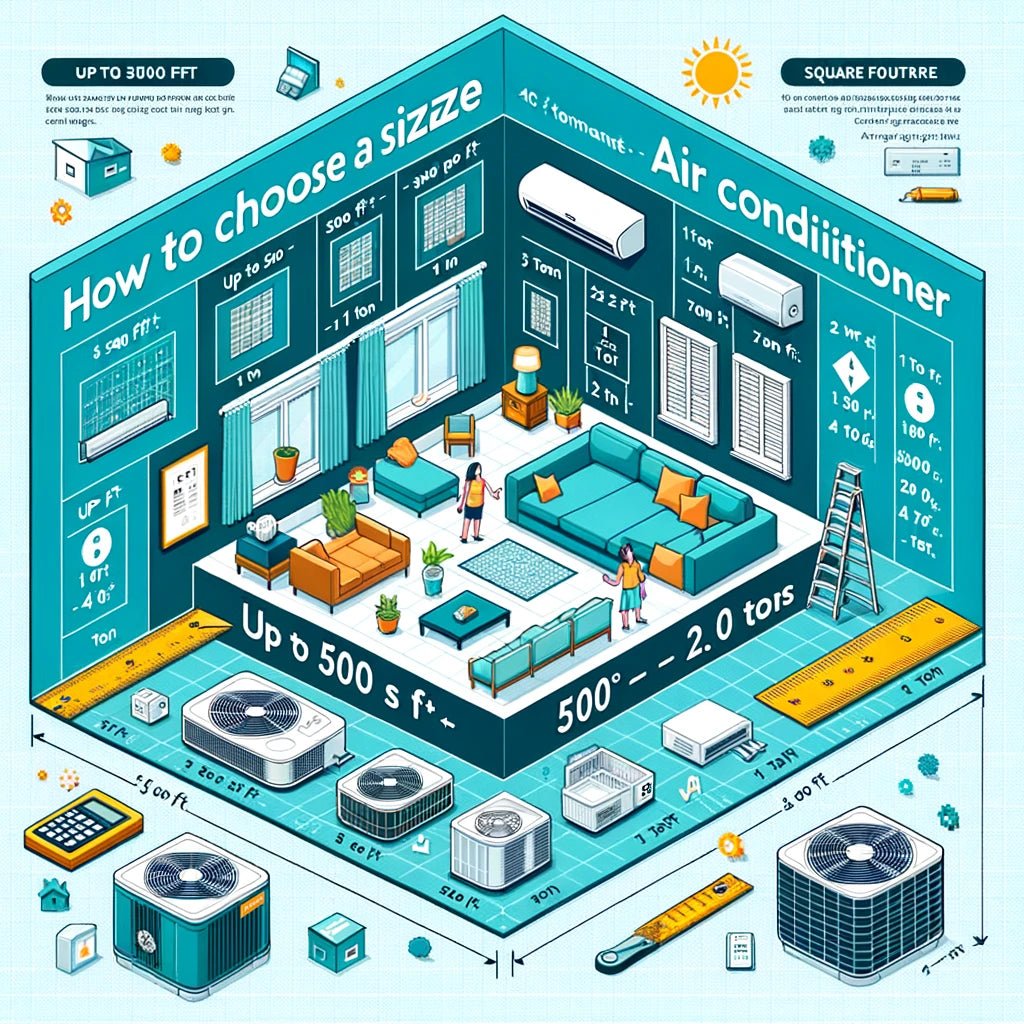Choosing the Right Size: Guidelines for Sizing an Air Conditioner Based on Square Footage
- 150–350 square feet: 5,000–8,000 BTU
- 350–550 square feet: 8,000–12,000 BTU
- 550–1,050 square feet: 12,000–18,500 BTU
- 5k–9k BTU ACs are for rooms of 150–400 square feet
- 12k–32k BTU ACs are for rooms of 550–1900 square feet
- 36k–60k BTU ACs are for a home area of more than 2700 square feet
- For a 100–130 square feet room, 0.8 to 1 ton AC is enough
- For a room of 130 square feet to 200 square feet, 1.5 ton AC is better
- Rooms more than 182–200 square feet require a 2 ton AC
- Rooms more than 500 square feet require more than one AC in multiple places
Air Conditioner Sizing Based on Square Footage (Estimates Only)
| Climate & Insulation Level | BTU Factor | Example: 1200 sq ft Room |
|---|---|---|
| Mild Climate, Well-Insulated | 20 BTU/sq ft | 24,000 BTU |
| Moderate Climate, Average Insulation | 25 BTU/sq ft | 30,000 BTU |
| Hot Climate, Poorly Insulated | 30 BTU/sq ft | 36,000 BTU |
Ensuring your home stays cool and comfortable during hot summers requires an air conditioner that's up to the task. But choosing the wrong size AC unit can lead to several problems, including inefficient cooling, increased energy bills, and even equipment damage.
This article provides guidelines for sizing an air conditioner based on the room's square footage, offering a starting point for your decision-making process. However, it's crucial to remember that these are just estimates, and several other factors come into play.
Square Footage as a Starting Point:
- Measure the square footage of the room you want to cool.
-
Multiply the square footage by a BTU (British Thermal Unit) factor based on your climate:
- 20 BTU/sq ft: Well-insulated, mild climate.
- 25 BTU/sq ft: Average insulation, moderate climate.
- 30 BTU/sq ft: Poorly insulated, hot climate.
Example: For a 1200 sq ft room in a moderate climate with average insulation:
- 1200 sq ft * 25 BTU/sq ft = 30,000 BTU
Important Considerations:
-
BTU estimates are a starting point, not a guarantee. They don't account for:
- Sun exposure: Rooms with south-facing windows or significant sun exposure will require more BTUs.
- Number of occupants: More people generate more heat, requiring a higher BTU capacity.
- Insulation level: Better insulation reduces heat gain, requiring fewer BTUs.
- Ductwork: Leaks in the ductwork can decrease efficiency, requiring a larger unit.
Beyond Square Footage:
While square footage is a helpful starting point, it's essential to consider the additional factors mentioned above for an accurate assessment. Consulting a qualified HVAC professional is highly recommended. They can:
- Perform a Manual J calculation: This industry-standard method considers all relevant factors to determine the exact cooling load (BTU requirement) of your space.
- Recommend the most suitable AC unit size: Based on the calculated cooling load, they can recommend an AC unit with the appropriate tonnage (cooling capacity) to ensure optimal performance and avoid oversizing or undersizing.
Remember:
- Oversizing an AC unit can lead to short cycling (frequent on-and-off cycles), reducing efficiency, increasing wear and tear, and potentially leading to comfort issues like uneven cooling.
- Undersizing an AC unit will struggle to maintain the desired temperature, leading to discomfort and potentially causing the unit to run constantly, increasing energy consumption and reducing its lifespan.
By understanding the limitations of square footage estimations and seeking professional guidance, you can make an informed decision about your air conditioner size, ensuring a comfortable and efficient cooling system for your home.


